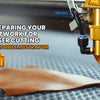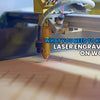Preparing Your Artwork For Laser Cutting in Adobe Illustrator
- oleh halim yahya
The three most commonly used file types we work with are .AI, .PDF, .DXF, and .JPEG.
We can engrave directly from JPEGs, but in order to cutting with laser machine a vector line is required.

Adobe Illustrator is command software used to prepare vector file. Follow these step to create a Artwork for Laser Cutting that can be used right away. The right step will reduce any additional cost that may arise due to artwork adjustments.
What do You Need To Do
- Set the document color mode to RGB.

- All cut lines should be RGB red with a stroke weight of 0.1.

- All scored lines should be RGB bgreen with a stroke weight of 0.1.

- Any raster engraving should have a black color fill. (Some of our machines can read grayscale, which is useful for engraving photographs. Please contact us if this applies to your project.)

Step 1
Ensure all text and fonts are outlined or converted to paths.
To do this, select Type > Create Outlines from the top menu.

Step 2
Release all clipping masks (Object Clipping Mask > Realease).
Step 3
Ungroup all items by selecting Object > Ungroup. You may need to repeat this if there are multiple small groups within a larger group.
Step 4
Ensure all your vector paths are continuous. If shapes are made up of multiple paths, join them to form a closed shape. This is important if you plan to engrave solid shapes.
Step 5
Reducing anchor points will simplify the drawing, helping to decrease cutting time and allowing the laser to process the file more efficiently.
Step 6
When cutting fonts and text, keep in mind that the inner parts of certain letters may fall out. To prevent this, it's recommended to either modify your chosen font to bridge these gaps or opt for an alternative stencil-style font.
Step 7
When drafting your drawing within Illustrator ensure there are no duplicate vector strokes stacked on top of one another. If these aren’t removed, the laser will cut or score these lines repeatedly, potentially ruining the material and damaging the laser bed.
Duplicates can be easily spotted, as their strokes will appear darker than other cutting lines. To remove them, use the Direct Select tool and delete until only single lines remain.
Checking Outlines:
View your design in Outlines mode (toggle with Ctrl+Y). This simulates how the laser cutter will "see" and process your drawing.
If you have any vector strokes that you don’t want to cut or engrave, use the Scissors Tool to trim them.
Purge Your File:
Clear all guides and stray vector points:
- Select Select > Object > Stray Points to delete stray vectors not connected to any path.
- Select View > Guides > Clear Guides to remove all guides from your file.
Step 8
Check for any hidden items around the edges of your artboard. A quick way to do this is to zoom out, select all, and look for any stray objects or lines.
Step 9
To get an accurate preview of how the laser cutting software will interpret your file, select View > Outline from the top menu.
Get a Quote – How Much Will It Cost?
It's challenging to provide an exact cost without reviewing your file. Ideally, we need vector files such as .AI, .DXF , or .SVG with an indication of scale set up as follows. However, feel free to send whatever you have to convey your idea.
We can also provide quotes for drawing work if needed.
Once we have the vector file, we can estimate machine time, any necessary changeovers, whether the material needs to be taped into the sheet, and any additional finishing methods required.
If you're planning a large production run, we can offer competitive pricing and with big discount.
- Disiarkan dalam:
- Laser Cut
- Laser Engrave
- Preparing Artwork
- Tips
- Tutorial









